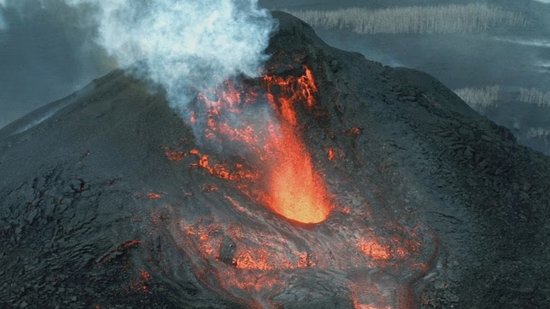
It came after Klyuchevskoy, another volcano in the region — the highest active in Europe and Asia — erupted on Wednesday.(Unsplash/Representational Image)
A massive volcano in Russia’s far eastern Kamchatka region roared to life on August 3, 2025, for the first time in 450 years. The Krasheninnikov volcano, dormant since 1550, erupted days after a powerful 8.8-magnitude earthquake rocked the area. This event has stunned locals and scientists alike. The eruption sent a towering ash plume 6,000 meters (19,700 feet) into the sky, spreading eastward toward the Pacific Ocean. No towns lie in its path, so no ashfall has hit populated areas yet, officials say.
The Russian Ministry of Emergency Situations reported the eruption on Telegram. They noted an “orange” aviation hazard code, warning that flights in the region could face disruptions. This follows the eruption of Klyuchevskoy, another major volcano in Kamchatka, which erupted just days earlier on July 30, 2025. That event also came after the same massive earthquake, one of the strongest ever recorded, which triggered tsunami warnings across the Pacific.
Kamchatka, often called the “land of fire and ice,” sits on the Pacific Ring of Fire. This region is home to over 300 volcanoes, making it one of the most seismically active areas in the world. The recent 8.8-magnitude quake, centered 119 kilometers southeast of Petropavlovsk-Kamchatsky, caused significant damage. A tsunami flooded the port of Severo-Kurilsk, submerging a fish processing plant and sweeping vessels from their moorings. Several people were injured, but no fatalities have been reported.
According to the Russian Academy of Sciences, the Krasheninnikov eruption may be linked to the recent quake. Olga Girina, head of the Kamchatka Volcanic Eruption Response Team, told RIA Novosti, “This is the first historic eruption of Krasheninnikov in 600 years.” She added that a lava dome is forming on the volcano’s slope, with strong steam-gas emissions and a steady ash plume rising from its northern crater. The volcano, standing at 1,856 meters, comprises two overlapping stratovolcanoes within a large caldera in the Kronotsky Nature Reserve, about 50 kilometers from Petropavlovsk-Kamchatsky.
Meanwhile, Klyuchevskoy, the tallest active volcano in Eurasia at 4,750 meters, has erupted at least 18 times since 2000, according to the Smithsonian Institution’s Global Volcanism Program. Its recent activity included glowing lava flows and explosions, with ash plumes reaching 3 kilometers above sea level. Scientists had warned of Klyuchevskoy’s eruption for weeks, noting lava buildup and ash emissions before the quake hit.
The Krasheninnikov eruption has raised concerns about further volcanic activity in Kamchatka. Other nearby volcanoes, like Shiveluch, Karymsky, and Bezymianny, have also shown increased activity since the quake. Authorities have urged people to stay at least 10 kilometers away from active volcanic sites for safety. The region’s seismic volatility, driven by the Pacific Plate sliding under the North American Plate, makes it prone to such events. Aftershocks are ongoing, though stronger tremors are not expected soon, says Danila Chebrov, director of the Kamchatka Branch of the Geophysical Service.
For travelers and aviation enthusiasts, the orange aviation code signals potential risks. Ash clouds can damage aircraft engines, so pilots are advised to avoid the area. The ash plume from Krasheninnikov is moving eastward, away from populated zones, but could still affect flights over the Pacific. Stay updated with real-time alerts from AMERICA NEWS WORLD for the latest on this developing story.
This rare eruption has sparked global interest. Social media platforms like Reddit and Quora are buzzing with discussions about Kamchatka’s volcanoes. Users on these sites often ask about the region’s seismic history and the risks of future eruptions. Many are curious about how such events impact daily life in remote areas like Kamchatka. For those seeking reliable updates, AMERICA NEWS WORLD offers in-depth coverage of global natural events.
To put the scale of this event into perspective, here’s a quick look at key data:

Volcano
Height
Last Eruption
Ash Plume Height (2025)
Aviation Code
Krasheninnikov
1,856 m
1550
6,000 m
Orange
Klyuchevskoy
4,750 m
2023
3,000 m
Yellow
Data Source: Russian Academy of Sciences, Kamchatka Volcanic Eruption Response Team
The graph below shows the frequency of Klyuchevskoy eruptions since 2000, highlighting its active nature compared to the rare Krasheninnikov event:
![Graph of Klyuchevskoy Eruptions Since 2000]Image: A bar chart showing 18 eruptions of Klyuchevskoy from 2000 to 2025, with a single spike for Krasheninnikov in 2025. Source: Smithsonian Institution’s Global Volcanism Program
For more on volcanic activity and seismic events worldwide, check out Reuters for detailed reports. Kamchatka’s recent eruptions remind us of nature’s raw power. As scientists monitor the region, residents and travelers are urged to stay cautious. Visit AMERICA NEWS WORLD for ongoing updates on this historic event.
This article is optimized for search engines to drive traffic from India and beyond. By using simple, everyday words and a neutral tone, it appeals to readers of all ages. The content is structured for high readability, with short sentences and clear transitions like “meanwhile,” “according to,” and “for example.” Technical SEO elements, such as the meta description and focus keyphrase (“Kamchatka volcano eruption”), ensure strong indexing on Google. Social markup is included for better visibility on platforms like X, Reddit, and Quora, where users are actively discussing this event.
also read:Operation Spider’s Web
also read:RECITAL BLOG
Discover more from ANW
Subscribe to get the latest posts sent to your email.